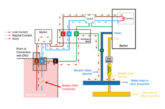
There’s lots of information out there that goes into great depth on what you should be testing and how you should go about it. Unfortunately, it’s not always easy to understand. Here Jacqueline Balian of GAMBICA offers advice on making sure you’ve got the right kit for the job.
Do you sometimes struggle to fully understand product specifications? Do you often worry that people are telling you what they think you want to hear?
Even if you’re the kind of person who regularly turns to BS EN61010 when you can’t lay your hands on any Nytol (other soporifics are available) it can be tricky to fully understand the meaning of measurement categories ratings for testing equipment, and where the boundaries lie within an electrical installation.
In fact, so many professional electricians are having to go back to equipment providers to check exactly which test equipment is appropriate for which job, that the industry has got together to develop some short, easy to read and understand guidance to help you know which instrument you should be using and when.
The guidance, titled The GAMBICA Guide to Overvoltage Categories and Measurement Categories, isn’t product specific. It has been produced by the UK Trade Association for the Test and Measurement industry, GAMBICA, in conjunction with all of the main UK based equipment providers.
You may not have heard of GAMBICA until now but the organisation has been in operation for over 40 years, providing advice and data for members and their customers, and is a key player in the development of British and European Standards for test equipment.
The guidance explains clearly and simply the meaning and significance of the different measurement and overvoltage categories specified in the relevant British Standards and the Health and Safety Executive’s guidance GS38.
Get the right category equipment for the job
Whatever measurements you’re making on a system, whether it’s continuity, resistance, or loop impedance, you will be using equipment which is rated for use at certain locations within the installation.
This safety rating is a requirement of BS EN61010 – the safety standard for test and measurement equipment, which says that test and measurement terminals must be marked with the value of the rated voltage to earth and the applicable measurement category, often abbreviated to “CAT.”
So, if you’ve bought equipment that conforms to the relevant safety standards, it will be either clearly marked with the measurement category and rated voltage or with a mark to let you know the relevant information can be found in the equipment documentation.
The category rating is normally next to the test terminals, as shown in the example picture below.
Measurement categories classify the terminals of test and measurement equipment according to the type of mains circuit to which they can be safely connected. The category takes into account overvoltage categories, short-circuit current levels, the location where the test is to be made, and some forms of protection included in the building installation. It is hugely important that an instrument with an appropriate measurement category and voltage rating is used.
Measurement terminals can be safely connected to a measurement category lower than the marking on the terminals, but the measurement terminals must never be connected to a circuit that exceeds the rated voltage or measurement category.
Understanding measurement categories
Measurement categories go from Cat II to Cat IV and the diagram (pictured below), taken from the new GAMBICA guidance, gives you an idea of where they can be used. The guidance also explains the transient overvoltages which can occur within electrical distribution systems.
They can be caused by atmospheric issues such as a lightning strike or be generated by equipment within an installation. Power electronic modules in particular, generate temporary voltage peaks in conjunction with inductive loads, which can be significantly higher than the nominal mains voltage.
Overvoltage categories and measurement categories are used to classify equipment according to its ability to withstand transient overvoltages.
Access a free copy of the Gambica guidance document by clicking here










